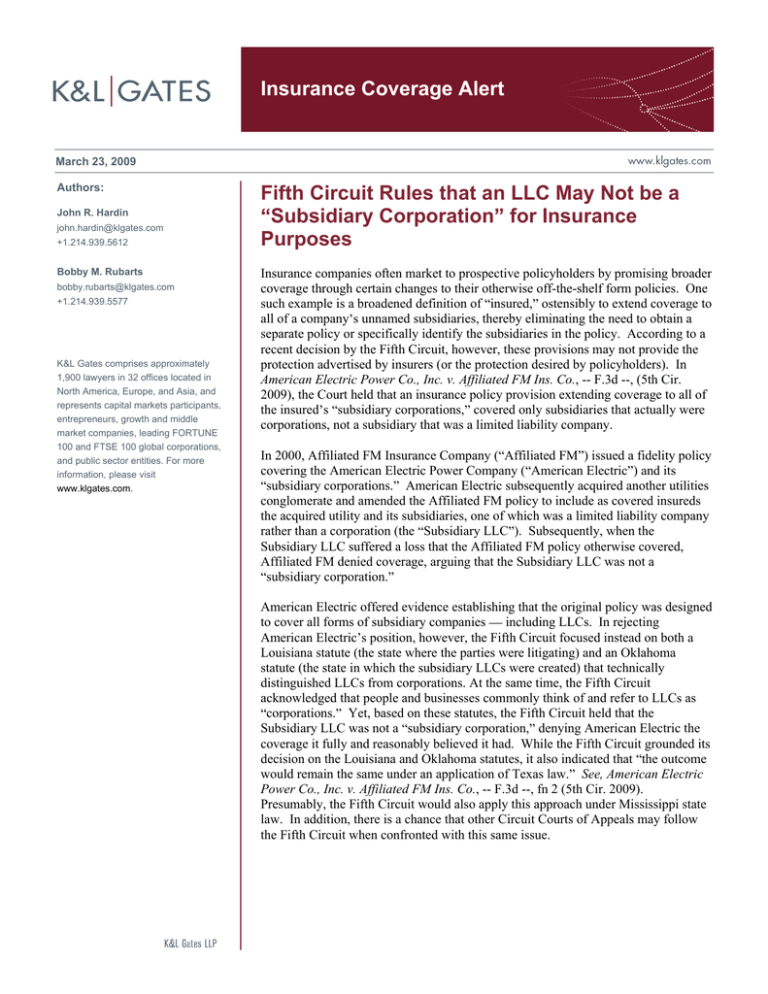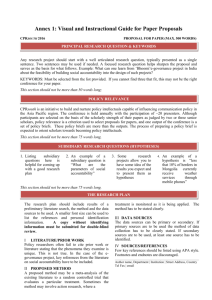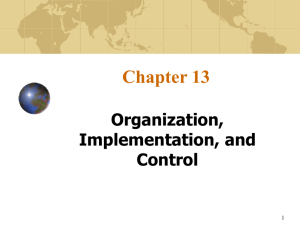
Insurance Coverage Alert
March 23, 2009
Authors:
John R. Hardin
john.hardin@klgates.com
+1.214.939.5612
Bobby M. Rubarts
bobby.rubarts@klgates.com
+1.214.939.5577
K&L Gates comprises approximately
1,900 lawyers in 32 offices located in
North America, Europe, and Asia, and
represents capital markets participants,
entrepreneurs, growth and middle
market companies, leading FORTUNE
100 and FTSE 100 global corporations,
and public sector entities. For more
information, please visit
www.klgates.com.
Fifth Circuit Rules that an LLC May Not be a
Subsidiary Corporation for Insurance
Purposes
Insurance companies often market to prospective policyholders by promising broader
coverage through certain changes to their otherwise off-the-shelf form policies. One
such example is a broadened definition of insured, ostensibly to extend coverage to
all of a company s unnamed subsidiaries, thereby eliminating the need to obtain a
separate policy or specifically identify the subsidiaries in the policy. According to a
recent decision by the Fifth Circuit, however, these provisions may not provide the
protection advertised by insurers (or the protection desired by policyholders). In
American Electric Power Co., Inc. v. Affiliated FM Ins. Co., -- F.3d --, (5th Cir.
2009), the Court held that an insurance policy provision extending coverage to all of
the insured s subsidiary corporations, covered only subsidiaries that actually were
corporations, not a subsidiary that was a limited liability company.
In 2000, Affiliated FM Insurance Company ( Affiliated FM ) issued a fidelity policy
covering the American Electric Power Company ( American Electric ) and its
subsidiary corporations. American Electric subsequently acquired another utilities
conglomerate and amended the Affiliated FM policy to include as covered insureds
the acquired utility and its subsidiaries, one of which was a limited liability company
rather than a corporation (the Subsidiary LLC ). Subsequently, when the
Subsidiary LLC suffered a loss that the Affiliated FM policy otherwise covered,
Affiliated FM denied coverage, arguing that the Subsidiary LLC was not a
subsidiary corporation.
American Electric offered evidence establishing that the original policy was designed
to cover all forms of subsidiary companies
including LLCs. In rejecting
American Electric s position, however, the Fifth Circuit focused instead on both a
Louisiana statute (the state where the parties were litigating) and an Oklahoma
statute (the state in which the subsidiary LLCs were created) that technically
distinguished LLCs from corporations. At the same time, the Fifth Circuit
acknowledged that people and businesses commonly think of and refer to LLCs as
corporations. Yet, based on these statutes, the Fifth Circuit held that the
Subsidiary LLC was not a subsidiary corporation, denying American Electric the
coverage it fully and reasonably believed it had. While the Fifth Circuit grounded its
decision on the Louisiana and Oklahoma statutes, it also indicated that the outcome
would remain the same under an application of Texas law. See, American Electric
Power Co., Inc. v. Affiliated FM Ins. Co., -- F.3d --, fn 2 (5th Cir. 2009).
Presumably, the Fifth Circuit would also apply this approach under Mississippi state
law. In addition, there is a chance that other Circuit Courts of Appeals may follow
the Fifth Circuit when confronted with this same issue.
Insurance Coverage Alert
Of course, notwithstanding this decision by the Fifth
Circuit, it is likely that not all courts will agree that
such subsidiary language is clear and
unambiguous in not including subsidiary LLC s.
Some courts may find the language at least
ambiguous and, thus, will construe its language
against the insurance company in favor of coverage
for the subsidiary. See e.g., Progressive County
Mutual Ins. Co. v. Sink, 107 S.W.3d 547 (Tex.
2003). In determining whether insurance policy
language is ambiguous, a court typically will
consider evidence of the surrounding circumstances
at the time the contract was executed. See e.g.,
Balandran v. Safeco Ins. Co. of America, 972
S.W.2d 738 (Tex. 1998). In this context, an
insurer s underwriting file and/or communications
with the broker may well establish that the insurer
considered the subsidiary company at issue as part
of its underwriting analysis. If the policyholder paid
premiums to cover its subsidiary, it should follow
that the policy s language would be construed to
cover it.
In any event, policy renewal time is a good time to
take steps to avoid this and other pitfalls in policy
language. On this particular point, care should be
taken to ensure the policy accurately describes the
parties intent to cover all of the policyholder s
subsidiaries, regardless of their respective legal
forms of organization. For example, instead of
limiting the definition of insureds to subsidiary
corporations or subsidiary partnerships, the
language should be worded broadly and include all
subsidiary companies of any and all legal forms,
including, but not limited to, corporations, limited
liability companies, partnerships, limited liability
partnerships, limited partnerships, and joint
ventures. Anything less inclusive runs the risk of
having some subsidiaries deemed to be covered
under the policy and some not, depending upon the
particular legal form of the subsidiary.
Alternatively, a policyholder should seek to list in
the policy each and every subsidiary entity
specifically so as to avoid any doubt.
In sum, in light of the Fifth Circuit s decision,
which inevitably will be noted and sought to be
exploited by many insurers, a corporate
policyholder should consider listing specifically
each and every subsidiary entity in the policy as to
avoid any doubt. If coverage is in doubt, it would
be better to request a change now
or receive
written assurances from the insurer that it considers
all subsidiaries covered
rather than wait until a
loss occurs and hope the insurer will not take the
same position as Affiliated FM in seeking to avoid
coverage.
K&L Gates comprises multiple affiliated partnerships: a limited liability partnership with the full name K&L Gates LLP qualified in Delaware and
maintaining offices throughout the U.S., in Berlin and Frankfurt, Germany, in Beijing (K&L Gates LLP Beijing Representative Office), in Singapore
(K&L Gates LLP Singapore Representative Office), and in Shanghai (K&L Gates LLP Shanghai Representative Office); a limited liability partnership
(also named K&L Gates LLP) incorporated in England and maintaining our London and Paris offices; a Taiwan general partnership (K&L Gates)
which practices from our Taipei office; and a Hong Kong general partnership (K&L Gates, Solicitors) which practices from our Hong Kong office.
K&L Gates maintains appropriate registrations in the jurisdictions in which its offices are located. A list of the partners in each entity is available for
inspection at any K&L Gates office.
This publication is for informational purposes and does not contain or convey legal advice. The information herein should not be used or relied upon
in regard to any particular facts or circumstances without first consulting a lawyer.
©2009 K&L Gates LLP. All Rights Reserved.
March 23, 2009
2





